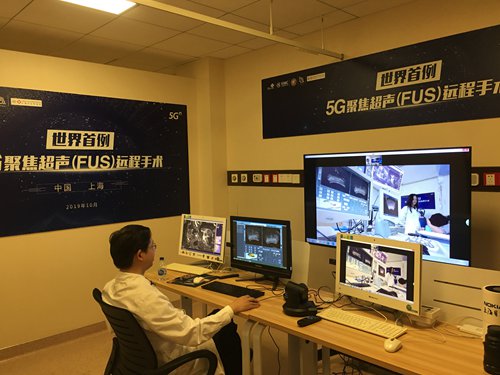HOME >> METRO SHANGHAI
The latest telecommunications technology benefits patients and hospitals
By Du Qiongfang Source:Global Times Published: 2019/10/30 17:38:41
5G healthcare is here
While most Chinese mobile users have not yet tried the amazing speed of the 5G networks, some doctors in Shanghai have.
Similar to scenarios described in sci-fi novels and movies, the doctor sitting in the control room of Shanghai International Medical Center (SIMC) controls the surgical equipment operating on the patient lying in the operating room of Shanghai Xuhui District Central Hospital about 30 kilometers away. It was the world's first focused ultrasound surgery (FUS) remotely accomplished through a 5G network.


"I was so overwhelmed by the news that the FUS can be performed remotely, especially that FUS can also be applied to cancers such as liver cancer, breast cancer, pancreatic cancer, kidney cancer and osteosarcoma," said 48-year-old Noemi Wang from the island of Taiwan, who had her uterine fibroids cured through FUS at the Xuhui hospital 10 years ago.
Wang happened to know about the then cutting-edge treatment that was in the initial stage of its development in the Chinese mainland. She was a bit concerned about the treatment in a Shanghai hospital, but still wanted to try, because in the island of Taiwan, she was told she had to have her uterus removed to have her illness cured, something she was unwilling to do. "I am really appreciated for this technology," Wang said.
Wang's brother was later diagnosed with liver cancer. "The local doctors asked us to prepare for a funeral because the 13-centimeter tumor was near diaphragm. But when I got to know that a combined treatment of hepatic artery embolism chemotherapy and FUS could be applied to liver cancer, we decided to have a try," said Wang, whose brother's cancer was finally cured.
Similar to scenarios described in sci-fi novels and movies, the doctor sitting in the control room of Shanghai International Medical Center (SIMC) controls the surgical equipment operating on the patient lying in the operating room of Shanghai Xuhui District Central Hospital about 30 kilometers away. It was the world's first focused ultrasound surgery (FUS) remotely accomplished through a 5G network.

Xu Yonghua conducts remote control surgery from SIMC. Photo: Courtesy of Xu Yonghua
Faster speed
According to Xu Yonghua, chair of the Department of Imaging and Interventional Radiology at Shanghai Xuhui District Central Hospital, who conducted the surgery earlier this month, the 5G-backed focused ultrasound remote procedure was the first remote surgery in the true sense of the word.
Previous surgeries with 5G needed surgeons to be present at the operating room, such as laparoscopic/endoscopic surgery, orthopaedic surgery and open surgeries, in which more experienced experts carefully observed and remotely instructed the operation away from the operation room with the help of the 5G. The lower communication latency and faster speed of 5G networks, contrasted with 4G, makes sure the instructions of the operation proceed smoothly.
Xu was performing an actual operation on the patient by controlling the focused ultrasound surgical equipment remotely. Xu blazed five uterine fibroids including the biggest of 4.8 centimeters in the patient's uterine by clicking with a computer mouse. "In the past, I had to sit next to the patients and closely observe their responses while performing the operations, but with the help of 5G, which assures smooth communication, I can perform the operations hundreds of kilometers away from the patients," Xu said.
Under the guide of type-b ultrasound, the doctor uses a computer to remotely control the surgical equipment which employs high intensity, focused ultrasound pulses to destroy diseased tissue of tumors or lesions inside a patient's body. It is a noninvasive surgical option without scarring, bleeding and with mild pain that does not require incisions into patient's body. Thus, the surgery involves minimal pain, low complications and quick recovery times. The patient neither bleeds nor needs anesthesia and can keep the normal organs and tissue intact.
After more than 20 years of clinical application, focused ultrasound therapy has covered more than 130 symptoms such as tumors, gynecology diseases and illness of urinary system. China has the largest number of the focused ultrasound therapies in the world.
The question begs, why can't FUS be accomplished with 4G? The remote surgery cannot be accomplished with 4G because of the latency. Since the patient stays fully awake and conscious during the entire procedure, the latency of 4G networks can cause mistakes if the patient even slightly moves his or her body while breathing. "We require absolute precision in our surgery and avoid damaging normal tissue and organs," Xu said.
According to Xu, with 5G, he can perform operations on patients from other Chinese provinces and from overseas countries and regions without having them travel to Shanghai, which can reduce the costs of treatment for patients and increase hospital revenue.
Xu has many patients who travel a long way from other provinces and overseas countries and regions such as Australia, New Zealand and Argentina to Shanghai. For patients, this means spending on transportation, food, accommodation and other necessities for traveling to the hospital.
However, if 5G technology is available in their local hospitals, the patients won't have to travel and the doctor based in Shanghai can perform operations on them remotely, Xu noted.
According to Xu Yonghua, chair of the Department of Imaging and Interventional Radiology at Shanghai Xuhui District Central Hospital, who conducted the surgery earlier this month, the 5G-backed focused ultrasound remote procedure was the first remote surgery in the true sense of the word.
Previous surgeries with 5G needed surgeons to be present at the operating room, such as laparoscopic/endoscopic surgery, orthopaedic surgery and open surgeries, in which more experienced experts carefully observed and remotely instructed the operation away from the operation room with the help of the 5G. The lower communication latency and faster speed of 5G networks, contrasted with 4G, makes sure the instructions of the operation proceed smoothly.
Xu was performing an actual operation on the patient by controlling the focused ultrasound surgical equipment remotely. Xu blazed five uterine fibroids including the biggest of 4.8 centimeters in the patient's uterine by clicking with a computer mouse. "In the past, I had to sit next to the patients and closely observe their responses while performing the operations, but with the help of 5G, which assures smooth communication, I can perform the operations hundreds of kilometers away from the patients," Xu said.
Under the guide of type-b ultrasound, the doctor uses a computer to remotely control the surgical equipment which employs high intensity, focused ultrasound pulses to destroy diseased tissue of tumors or lesions inside a patient's body. It is a noninvasive surgical option without scarring, bleeding and with mild pain that does not require incisions into patient's body. Thus, the surgery involves minimal pain, low complications and quick recovery times. The patient neither bleeds nor needs anesthesia and can keep the normal organs and tissue intact.
After more than 20 years of clinical application, focused ultrasound therapy has covered more than 130 symptoms such as tumors, gynecology diseases and illness of urinary system. China has the largest number of the focused ultrasound therapies in the world.
The question begs, why can't FUS be accomplished with 4G? The remote surgery cannot be accomplished with 4G because of the latency. Since the patient stays fully awake and conscious during the entire procedure, the latency of 4G networks can cause mistakes if the patient even slightly moves his or her body while breathing. "We require absolute precision in our surgery and avoid damaging normal tissue and organs," Xu said.
According to Xu, with 5G, he can perform operations on patients from other Chinese provinces and from overseas countries and regions without having them travel to Shanghai, which can reduce the costs of treatment for patients and increase hospital revenue.
Xu has many patients who travel a long way from other provinces and overseas countries and regions such as Australia, New Zealand and Argentina to Shanghai. For patients, this means spending on transportation, food, accommodation and other necessities for traveling to the hospital.
However, if 5G technology is available in their local hospitals, the patients won't have to travel and the doctor based in Shanghai can perform operations on them remotely, Xu noted.

Photo: VCG
Benefiting patients"I was so overwhelmed by the news that the FUS can be performed remotely, especially that FUS can also be applied to cancers such as liver cancer, breast cancer, pancreatic cancer, kidney cancer and osteosarcoma," said 48-year-old Noemi Wang from the island of Taiwan, who had her uterine fibroids cured through FUS at the Xuhui hospital 10 years ago.
Wang happened to know about the then cutting-edge treatment that was in the initial stage of its development in the Chinese mainland. She was a bit concerned about the treatment in a Shanghai hospital, but still wanted to try, because in the island of Taiwan, she was told she had to have her uterus removed to have her illness cured, something she was unwilling to do. "I am really appreciated for this technology," Wang said.
Wang's brother was later diagnosed with liver cancer. "The local doctors asked us to prepare for a funeral because the 13-centimeter tumor was near diaphragm. But when I got to know that a combined treatment of hepatic artery embolism chemotherapy and FUS could be applied to liver cancer, we decided to have a try," said Wang, whose brother's cancer was finally cured.
Posted in: METRO SHANGHAI